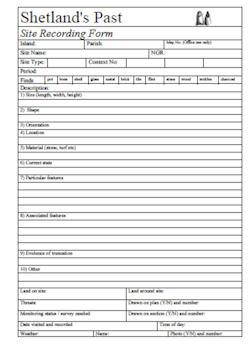Sites and Monuments Record
|
If you have been directed to this page from Pastmap and would like more information on a site, please email info@shetlandamenity.org quoting the SMR number(s) which you are interested in or phone 01595 694688 and ask for the Archaeology Section. |
Shetland’s Sites and Monuments Record, known in some other authority areas as an Historic Environment Record, is compiled and maintained by the Archaeology Section. Records are gathered and kept on any and all aspects of our environment which have been built or influenced by human involvement, from the earliest known, though to more contemporary structures. The purpose of keeping records is multi-faceted, including the need to protect and preserve history, while learning for the future, and enjoying the history that surrounds us.
 There is a strong emphasis on prehistoric – Viking/Norse sites in Shetland, but there are now over 300 World War sites on the Record and this component is increasing. The records which are held arise from a number of sources: local informants and visitors, published volumes, research results, the 1960s Ordnance Survey Record Cards and the surveys and recording exercises of Shetland Amenity Trust staff. All entries are checked wherever possible.
There is a strong emphasis on prehistoric – Viking/Norse sites in Shetland, but there are now over 300 World War sites on the Record and this component is increasing. The records which are held arise from a number of sources: local informants and visitors, published volumes, research results, the 1960s Ordnance Survey Record Cards and the surveys and recording exercises of Shetland Amenity Trust staff. All entries are checked wherever possible.
The SMR is the primary tool used by the Archaeology Section for Development Control, but it is also used to answer queries from anyone with an interest in the past, including school children, walkers, researchers, etc. The Trust always welcomes information and photographs from people who believe that they have discovered new sites – and if people wish to make a full record of what they have found, there are forms and even training, which can help with that through the Shetland’s Past Project.
To submit details of a new site, download the Site Recording Form and return it to the Archaeology Section at Shetland Amenity Trust offices.
Our records are now links to GIS and there are plans to make the database available online in future.



